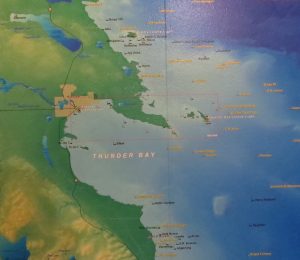ALPENA, Mich. (Michigan Back Roads) – A visit to the Great Lakes Maritime Heritage Center will open a whole new world of discovery. This is the only National Oceanographic and Atmospheric Agency (NOAA) location at a freshwater facility in the world.
The facility offers a number of entertaining and educational programs that highlight the value of our irreplaceable natural resources. The conservation and preservation of the Great Lakes, containing 20% of the fresh water on earth, is what the work here is all about.
MORE NEWS: Muslim Dearborn Teacher: U.S. Is ‘World’s Worst Terrorist’
The Heritage Center is the starting point for exploring the Thunder Bay National Marine Sanctuary that protects the shipwrecks and the diving areas. The welcome center offers 10,000 square feet of interactive exhibits showcasing the history, shipwrecks, and archaeology of Thunder Bay specifically, and the Great Lakes in general. There are several excellent maps showing the location of shipwrecks with details about some of the more famous. One unusual exhibit is a full-size replica of a wooden Great Lakes schooner. Visitors can climb aboard and experience what a Great Lakes storm would feel like on the tossing deck. Those storms have caused the demise of many a ship.

A popular way to explore some of the 100+ shipwrecks in and near the bay is by boat. In the warm months, glass bottom boat tours around the bay are available. Wind conditions determine which wrecks the tour covers. Some of the wrecks are more than 80 feet below the surface. Still, they are perfectly visible due to the clarity of these waters. A few miles away is the 40 Mile Point Lighthouse. The Joseph S. Fay became stranded there in 1905. The wreck is still there, in shallow water, making it a favorite to visit.
Among the valuable educational programs supported by the Sanctuary is an underwater robotics competition. The competition allows students to engage in underwater missions using underwater remote operated vehicles. The missions are based on real world scenarios like exploring sunken ships. It was this kind of vehicle that was used to help map and photograph the constructions, deep underwater, on the Alpena-Amberly ridge.
There, on the floor of Lake Huron, is the ancient land bridge that stretched from Alpena to Ontario, 9,000 years ago. The Alpena-Amberly land bridge was a migration route for caribou. Human hunters constructed stone structures designed to channel the animals into killing zones. The structures are still there, deep underwater. When these structures were built, the environment was far different than today. The land bridge was above the water. The immense glacier that was carving out the Great Lakes was receding north. At that time the glacier was only about 100 miles north, and was visible, as it was still nearly a mile thick. Remarkably, the constructions bear a resemblance to those built and in use today in arctic regions, where caribou still follow the annual migration patterns. Without preservation and exploration in clean clear waters, these artifacts might have been lost forever.
